[Trade Journal]
Publication: Engineering (London)
London, England
p. 335-338, col. 1-3
HIGH-TENSION INSULATORS.
By E. H. CRAPPER, M.I.E.E.
IT is only of comparatively recent years that the supply of electric power over considerable distances has brought into prominence the subject of high-tension currents, and the probability of an early introduction of overhead high-pressure line wires in this country now awakens fresh interest in the problem of the transmission of these currents. In the following article it is proposed to consider only one aspect of the problem — i.e., the important subject of insulators for high-pressure wires. It is generally acknowledged that the marvelous development of electric power transmission which has taken place, both in America and on the Continent, is largely due to the fact that, unlike the case in the British Isles, high-tension lines may be run through the open country, and even through small towns, the conductors being simply supported overhead at the top of tall poles by special insulators set in pins placed in cross arms carried by the poles.
Now, if there is one factor which stands out more prominently than any other in the design of a line to secure satisfactory service and an uninterrupted supply of power, it is the fact that the integrity of the line depends upon the adaptability of the insulator to the condition of the service to he rendered. The insulation of the line should be as perfect as possible, and, other things being equal, interruptions due to line troubles depend upon the magnitude of the voltage employed, the length of the line, and the number of branch circuits forming the distribution portion of the system. As a general rule, the greater the length of transmission the higher is the pressure. In fact, the present tendency—abroad at least—is the adoption of very high pressures for transmission purposes, and on this account the question of leakage becomes more and more serious, and consequently the perfection of the insulator becomes more and more necessary. For instance, the arcing or striking distance of 40,000 and 50,000 volts over wet and dusty surfaces is large, and it is imperative that the engineer should recognise the part played by the insulator in high-pressure transmission work, and also realise the importance of preventing the leakage of current from the line to earth or to adjacent wires.
During the early or pioneer stages of aerial transmission, by means of moderately high pressures, the ordinary form of insulators employed in telegraphy were tried, and their imperfections soon detected. A process of evolution then followed. Fortunately, the experience gained by American and Continental engineers is at our service; and the study of the evolution of the high-tension insulator from its more primitive forms affords both interesting and instructive reading. The demand made upon the manufacturer for an improved insulator has resulted in the production of the high-tension insulator, and satisfactory insulators are now available for pressures of 40,000 volts and upwards. The successive stages in the development of the high-tension insulator followed immediately upon the increases in the voltages which have been introduced from time to time since 1893, and the requirements which practice has shown to be necessary may be best demonstrated by tracing the steady growth in the transmission pressures.
 |
| Fig. 1. |
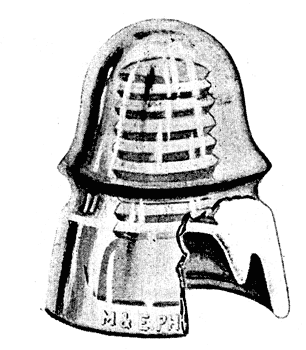 |
| Fig. 2. |
The beginning of the epoch of high-tension transmission dates from 1891, when the Frankfort Exhibition was held, and the famous Frankfort-Lauffen transmission experiments were conducted in connection therewith. These experiments demonstrated the possibilities of high-pressure alternating currents in supplying power at great distances--110 miles in this case—and voltages as high as 28,000 volts were tried for short periods; porcelain insulators, with an oil-cup something like the type shown in Fig. 1, page 336, being used. This early attempt, confirmed by later experience, to secure protection against leakage by the addition of an oil groove proved that oil cannot be kept clean, and that the introduction of oil is more of a disadvantage than an advantage, since the accumulation of dust on the surface of the oil diminishes its insulating value, and the method is now discarded. To make this brief historical record complete it is only right to mention that the first alternating-current power-transmission scheme was introduced in the United States in 1890, in which case the voltage was 3000, and glass insulators of the type shown in Fig. 2, page 336, were employed. Before the use of oil was entirely discarded, attempts were made in connection with the Pomona-San Bernardino (California) scheme in 1892 to introduce a petticoat projecting from the body of the insulator, and dipping into a detachable oil-cup of circular form, for pressures as high as 10,000 volts; but these oil-cups were found to be unnecessary.
Having found in actual practice that insulators without oil-cups were superior, other things being equal, two modifications were made in the form of glass and porcelain insulators possessing petticoats to gain the protection necessary against the increase of arcing range which accompanied the increases of the voltages employed. The ideas underlying the principles of the two resulting types of insulators were:—
1. That leakage is most likely to follow the surface, especially if it be wet or dusty; and
2. That the discharge which occurs when an insulator spills over is from petticoat to petticoat across the air space, and not along the surface.
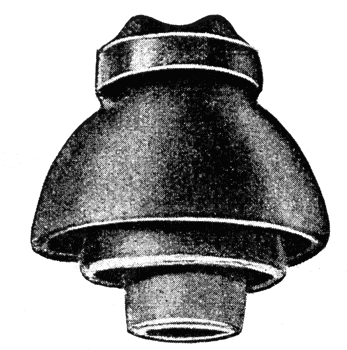 |
| Fig. 3. |
According to the former idea, the insulator with relatively small diameters and rather deep and nearly vertical petticoats, as shown in Fig. 3, were introduced, whilst the latter idea led to the construction of the mushroom type of insulator, with the upper petticoat, of fairly large diameter, projecting outwards almost horizontally. Now further experience with high voltages has proved that an insulator does "spill" over in precisely the manner suggested by the second idea; and, so far, the mushroom type of insulator is justified. But it is also true that in bad weather, when the surfaces are thoroughly wet, discharges over the surface are particularly likely to lead to spilling over, and it is not advisable to shape the petticoats so that the interiors are freely exposed to the elements. Hence modern insulators tend to forms which impede surface leakage by means of two or more extended petticoats, which present a sufficient distance between the edges of the petticoats without freely exposing the interiors, as shown in Figs. 4 and 5.
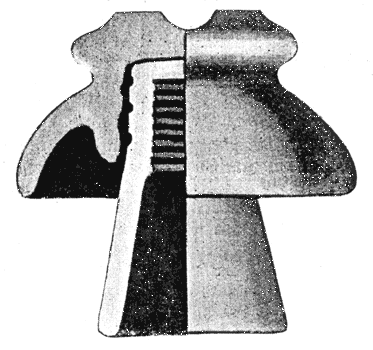 |
| Fig. 4. |
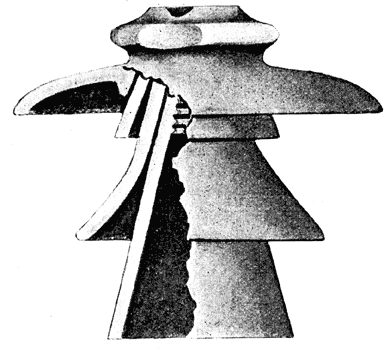 |
| Fig. 5. |
The insulator first used by the Niagara Falls Power Company is known as the "Type C" insulator and is shown in Fig. 6, the voltage at that time (1893) being 11,000 volts. In 1900 a second line was erected, in which the Type E insulator (Figs. 7 and 8) was used, and the pressure raised to 22,000 volts in 1901. The Type C insulator was particularly defective in respect to its mechanical attachment to the pin, which was but in. in diameter at the top, while the number of screw-threads engaging the pin with the insulator was but six; whilst the pin used with the Type E insulator is 1-1/2 in. in diameter at the top, and nine threads secure the insulator to the pin. The Type E insulator is made by the Locke Insulator Manufacturing Company, of Victor, New York, and is also used for the 101-mile transmission plant of the Guanajuato Power and Electric Company, in Mexico, which company is now using a pressure of 60,000 volts.
 |
| Fig. 6. |
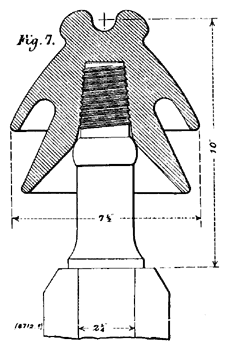 |
| Fig. 7. |
 |
| Fig. 8. |
In 1895 a pressure of 13,000 volts was in use at the Hochfelden-Oerlikon transmission scheme in Switzerland, and a pressure of 16,000 volts was introduced in the United States in 1897. The first commercial very high-voltage system, however, was introduced in 1898, at Provo, Utah, United States, the pressure being 40,000 volts. The insulators were made of glass, and were designed to provide unexposed surface near the wire in order to impede surface leakage; 60,000 volts was introduced in 1900 in connection with the Bay Counties and Standard Electric Companies of California, in which case the mushroom type of insulator, with a petticoat in the form of a sleeve fixed around the pin, was employed. The type of insulator which was introduced in 1901 for the 55,000-volt system of the Missouri River Power Company in Montana is shown in Fig. 9, from which it will be noticed that the insulator is formed of two separate parts—one, a hood 9 in. in diameter, and the other a glass sleeve set over the pin. The sleeve, which is open at the top, adds nothing to the dielectric strength of the insulator, its purpose being to protect the wooden pin. Obviously, the sleeve would be of little value if a metal pin were used; but this type of insulator possesses the advantage of being in two parts, which are separable, either of which can be replaced if broken. The insulator used for the 50,000-volt transmission at Shawinigan Falls, Quebec, is shown in Fig. 10. This is of porcelain, and made in sections. Each section has a closed top, and adds to the dielectric strength of the insulator. Two petticoats, one 9 in. and the other 10 in. in diameter, extend outward and give the effect of one insulator over another. One section extends down around the wooden pin and serves to protect the pin. The sections are held together with Portland cement. This insulator combines the advantage of a sleeve around the pin, outwardly-extending petticoats, and of separable parts.
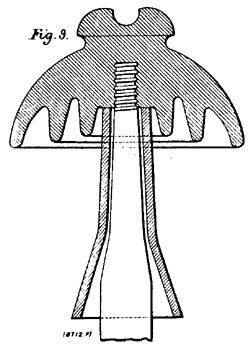 |
| Fig. 9. |
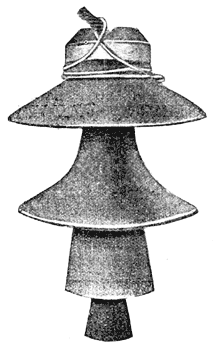 |
| Fig. 10. |
It is perfectly clear that high-voltage insulators require special attention in the design and manufacture, and, considering the production of these insulators as a problem in design, there are four essential features which demand careful consideration—i.e., resistance to puncture, the resistance to arcing to pin or cross-arm, proper distribution of electrostatic strains, low capacity, and sufficient creeping surface. The essential requisites of an insulator for high-pressure transmission are obviously (a) electrical, and (b) mechanical, both of which must be permanent and not liable to deterioration with service.
(a) The electrical requirements are:--
1. Impenetrability, or sufficient dielectric strength to resist puncture and to prevent discharges passing directly through the material.
2. The proper form and dimensions to impede the transference of electricity over the surface of the insulator.
3. Sufficient distance around the insulator between the conductor and the pin or support to prevent arcing.
4. Small electrostatic capacity,
(b) The mechanical requirements are:--
1. Mechanical strength to withstand mechanical strains and vibratory shocks.
2. Convenience of contour, so that they may be easily cleaned.
3. The material should be homogeneous and compact, and there should be no fractures or spongy places.
4. Convenience for mounting and for fastening the wire.
In the case of insulators in which the petticoats flare widely or are short, it is found that there is usually less concentration of electrostatic strain on the inner petticoat, and, consequently, less liability to puncture. Resistance to arcing is chiefly proportional to the longest combined air and insulator surface path which the discharge can be forced to take in passing from the wire to the pin or cross-arm. With regard to electrostatic strains, the noise and display of an insulator under test may be taken as an indication of its static capacity and effectiveness of material distribution. The point of visible static discharge should be kept at least as high as the full line voltage, in order that no insulator should be subjected to undue strain. The length of creepage path should be made as great as is consistent with reasonable design.
Local and climatic conditions should also be taken into account in deciding the form and dimensions of a high-tension insulator. As a general rule, the insulator should be larger for a locality where the climatic conditions are severe than for localities which are not accustomed to heavy rains, sleet, or dust-storms. Usually a larger type of insulator is required for the same voltage in a cold country than in a warmer climate. Whilst considering climatic conditions, the following remarks by Professor W. E. Goldsborough are worthy of notice:—"As the pressure on a transmission line is increased the line insulation is less and less affected by weather conditions. If insulators under favourable laboratory conditions withstand the high-voltage test, they will probably give ample satisfaction when installed on the line, as the energy dissipated by leakage over a damp insulator quickly dries it, and a further accumulation of moisture is curtailed by the electrostatic repulsion of the vapour particles. The full pressure should never be suddenly thrown on a transmission line that has been out of use. The circuit should be closed when the generators are only partly excited, and the voltage gradually built up. By following this plan the line is seasoned or dried out before the maximum voltage is reached, and the danger of a breakdown is greatly reduced."
The ability of an insulator to prevent surface arcing depends upon its dimensions and shape, and to the latter is due (1) protective action against moisture and rain, and (2) the property of giving origin to electrostatic phenomena. In connection with the size of an insulator, it should be noted that an increase in the dimensions introduces difficulties in supporting the insulator as well as a broader leakage path, and, as the present tendency is towards long spans, it is obvious that it is more difficult to satisfy the mechanical requirements of a high-tension insulator as the dimensions are increased.
Many different substances have been called into requisition in the endeavour to make satisfactory insulators, and many substances have been subjected to experiment and test, the chief of which are porcelain, glass, hard rubber, and various compounds of vegatable and mineral matter. Porcelain and glass have proved themselves superior to all others, and it is noteworthy that both possess naturally the necessary insulating qualities; but, at the same time, they are weak mechanically. The merits of glass and porcelain appear to be almost equally divided; glass is undoubtedly more brittle and weaker than porcelain, and is more hygroscopic. When the insulators are large, and the form complicated, difficulty is experienced during the manufacture in annealing the glass and in obtaining a good surface. Glass is, however, slightly cheaper, and it possesses the advantage of being transparent, thus enabling internal defects to be readily detected, and some American engineers have a decided preference for glass insulators. As regards numbers, however, the insulators constructed of porcelain exceed those made of glass. As regards the manufacture of glass insulators, it may be mentioned that generally a cheap kind of soda glass made of reasonably pure sand is used. When finished, the insulators are somewhat green in colour, the coloration being due to the presence of slight traces of iron oxide, no attempt being made to remove the last traces of the metallic impurities. This coloration, however, is not deep enough to render them opaque.
As regards porcelain, the process of manufacture varies somewhat with different makers; but it is very essential that every care should be taken in selecting materials of the best quality, so as to secure such faultless proportions of the ceramic composition as will withstand the very high temperatures involved in the baking and manufacture of the insulators, and also avoid deformation and the possibility of producing internal cracks, which naturally diminish the resistance to puncture. Porcelain as air insulator is useless, unless it is dense and properly vitrified throughout, and this necessitates firing at extremely high temperatures. Now whilst the requisite di-electric resistance or impenetrability may be secured by increasing the thickness of the sections, it must be borne in mind that there is a limit to the increase in the thickness of the material used. It is impossible to secure that uniform thermal treatment throughout the material which is absolutely necessary to bake the specimens evenly, and obtain continuity of structure if a certain thickness be exceeded. It is because of the difficulty experienced in getting the large mass of porcelain at the neck properly vitrified throughout that this part of the insulator is frequently the weakest part. One of the simplest tests to determine whether the material is properly vitrified and the insulator of good quality is to apply ink to a fracture; if the ink be not drawn up into the material, and washes off without leaving a trace behind, the insulator is satisfactory.
